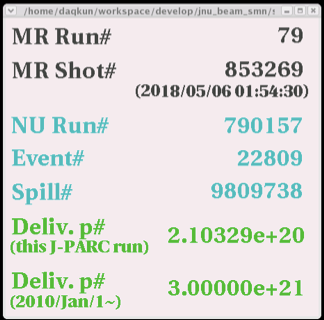T2K Run 9 ends with record proton delivery

T2K ended its 2017-18 data-taking run on May 31, 2018, with a record power of 500 kW delivered by the J-PARC Main Ring accelerator. T2K has accumulated a total of 3.16×10^21 protons on target (POT) so far. Preliminary results from a subset of these data were presented at the XXVIII International Conference on Neutrino Physics and Astrophysics (Neutrino 2018) in Heidelberg, Germany, on June 4 2018. Scientific results from the full data set will be released in the summer 0f 2018.
The protons are produced by the J-PARC Main Ring synchrotron accelerator in Tokai on the east coast of Japan. The 30 GeV protons are directed onto a graphite target, producing charged pions and other secondary particles. These pions pass through three magnetic “horns,” which are able to preferentially focus either positively-charged or negatively-charged pions in the direction of T2K’s neutrino detectors. Positively charged pions quickly decay to produce muon neutrinos , while negatively charged pions decay to produce muon antineutrinos. This allows T2K to produce a beam composed mostly of muon neutrinos or muon antineutrinos by changing the direction of the magnetic horn current.
J-PARC delivers 3.0e21 protons on target to T2K!
On May 5, 2018, the number of protons delivered to the neutrino target of the T2K experiment by the J-PARC accelerator reached an important milestone: 3×10^21 accumulated since January 2010. Many thanks and congratulations to the J-PARC accelerator teams for their outstanding work to make this possible !

The protons are produced by the J-PARC Main Ring synchrotron accelerator in Tokai on the east coast of Japan. The 30 GeV protons are directed onto a graphite target, producing charged pions and other secondary particles. These pions pass through three magnetic “horns,” which are able to preferentially focus either positively-charged or negatively-charged pions in the direction of T2K’s neutrino detectors. Positively charged pions quickly decay to produce muon neutrinos , while negatively charged pions decay to produce muon antineutrinos. This allows T2K to produce a beam composed mostly of muon neutrinos or muon antineutrinos by changing the direction of the magnetic horn current.
The number of protons delivered by the accelerator to the neutrino generating target is called “Protons on Target (POT)”, which is the typical performance indicator for the data volume of accelerator-based neutrino experiments, like T2K. For discoveries of new physics in the neutrino sector, we are aiming to maximise the accumulation of POT.
T2K is operating stably with an average beam power of about 495 kW in 2018.
T2K and NOvA collaborations to produce joint neutrino oscillation analysis
The NOvA and T2K Collaborations are working towards the formation of a joint working group to enhance the measurements of neutrino oscillation parameters made by each Collaboration individually. The projected timescale of the NOvA-T2K working group is for production of a full joint neutrino oscillation analysis by 2021.


